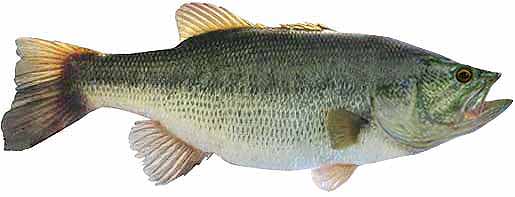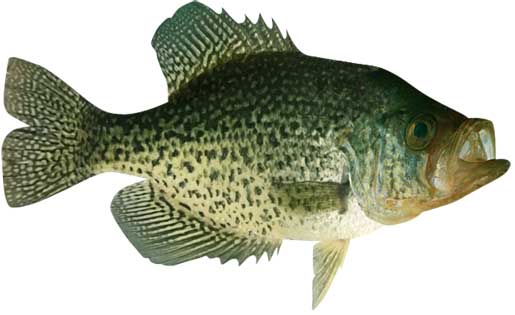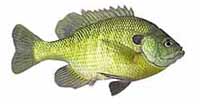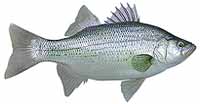Fishing Report For Belews Lake, NC
By Rick Seaman
Last updated on .
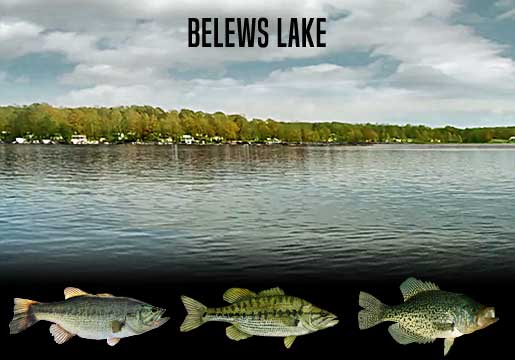
Fishing Reports
Popular Fish Species Belews Lake, NC
Largemouth Bass
Current Report: Good To Very Good
Not a lot of bass fishermen know about Belews Lake, but those that do, report excellent fishing nearly year round.
FALL. Now that Fall has arrived, bass here have moved shallow, following schools of baitfish into coves and shallow bays around 8 to 25 feet of water. Currently topwater, jerkbaits, crankbaits, and slow-rolled spinnerbaits are catching most of the bass. Later in Fall, as deeper water cools, bait and bass move out to ledges, channel edges, points and humps where flutter spoons, jigs and drop shots are often good choices in 20 to 40 feet of water.
WINTER. Thanks to warm water from the power plant the lake stays warmer in Winter than other lakes in the area. Winter will isolate largemouth around slightly deeper structure, flats, points and creek channels. They can typically be found from 20 to 40 feet deep - often deeper. Here they hold, feeding less frequently, awaiting warmer water to return in Spring. Slow presentations are key to getting bites. On warmer days, especially during late afternoons, bass may move into shallower water to feed. Fishing for largemouth bass here may take stealth tactics as the bass often hold deep - 50' or more. However, some locals report also catching bass shallow year round, even on topwater baits and crankbaits, in winter.
SPRING. Once water temperatures rise into the low 60's, largemouth will move from deep wintering holes, to shallower water nearby spawning areas. Vibrating jigs, jerkbaits and spinnerbaits typically get bites just away from the shoreline. At this time they are feeding aggressively in about 10 to 25 feet of water, preparing for the spawn. Once water warms into the mid to high 60's, they will move into 3 to 12 feet of water, and create nests, then lay their eggs. Immediately afterwards, females move to deeper water and males remain to guard the eggs, and then the fry. After a couple weeks, the males also move to slightly deeper water. Deep-diving crankbaits, vibrating jigs, plastic worms and swimbaits are catching bass during this period.
SUMMER. Water temperatures will warm considerably in Summer. Bass will feed shallow, early and late in the day, where they will be caught in 10 to 15 feet of water, on square-bill crankbaits and spinnerbaits. Largemouth bass here feed on gizzard shad, threadfin shad, small sunfish and crawfish. During the hotter parts of the day, they are being caught on points, channel edges, and ledges 15 to 35 feet deep. Some good reports come from anglers fishing for suspended bass, holding above deeper structure.
Spotted Bass
Current Report: Good To Very Good
Belews Lake is also well known as an exceptional spotted bass fishery. So good in fact, that bass tournaments for spotted bass only, are often held on the lake.
FALL. As Fall cools the shallows, spotted bass here follow schools of baitfish into coves and bays. Many tournament anglers report catching spots on tube baits, fished on light line. Stick worms are also working here, fished wacky style or on a small jighead. I like to dead-stick these worms for 15 to 30 seconds, then twitch them.
WINTER. Winter will draw them in large groups, around deeper structure, points and creek channels - anywhere there is baitfish. They can be found from 25 to 50 feet deep in Winter. Here they hold, often suspended near structure or along deep ledges, feeding less aggressively, waiting warmer water to return in Spring.
SPRING. With water temperatures in the in the low 60's now, spotted bass have moved from deep wintering areas to depths of 15 to 30 feet, just outside spawning bays and coves. They are focused on the spawn. Once water warms into the high 60's, they move into even shallower water, and create nests, then lay their eggs. Immediately upon spawning, females move to deeper water around 15 to 25 feet deep. Males remain to guard the eggs, and then the fry. After a couple weeks, the males join the females. Deep-diving crankbaits, slow-rolled spinnerbaits, small jigs, plastic worms and swimbaits catch plenty of Spring spotted bass.
SUMMER. Early and late in the day, spots are being caught on steep, rocky banks, ledges, humps and drop-offs, in 8 to 20 feet of water, sometimes even deeper. At night they may venture shallower to feed. They tend to gather in small schools and hold, preferring to move up and down the water column on steep banks looking for food and ideal water temperatures. They are occasionally feeding shallow, early and late in the day, where they are being caught on topwater, crankbaits and swimbaits. Drop-shots, Ned rigs, and wacky-rigged stick worms are catching finicky bass when they are deeper. They feed here on shad, small sunfish and crawfish. During the hotter parts of the day, they are being caught on points and ledges 30 to 60 feet deep.
Black Crappie
Current Report: Poor To Good
Crappie fishing can be hit or miss on Belews Lake. Locals report better fishing at night, than during mid day. The first and last hour of daylight is always a good time to be on the water.
FALL. Baitfish, which are moving into shallow flats, coves and bays, are drawing crappie into these areas. Nice crappie are being caught while feeding heavily, in preparation for the cold Winter. Anglers report that 8 to 25 feet of water is where most bites are coming. Minnows, hair jigs, and crappie jigs, are good options during this feeding marathon. Late fall starts the migration deeper, toward winter holding areas, for both crappie and baitfish. Small flutter spoons, fished in 15 to 30 feet of water, are a good option during this transition. Good results are coming around points, creek channels, and brush piles.
WINTER. Once the shallows start cooling rapidly, crappie will migrate to deeper holding areas, mostly off shore. At this time they are typically caught using a very slow presentation, in 15 to 40 feet of water. Most are caught around deep brush piles, creek channel bends, submerged timber, and main-lake structure. If they are suspending in open water, they often relate to some cover, or structure change, directly below them. During warming trends, especially warm afternoons, they are drawn into 8 to 12 feet of water to feed.
SPRING. In early Spring, crappie begin staging in 8 to 20 feet of water, just outside spawning bays and shallow flats. Spring is prime time to be on the water, as crappie have moved shallow to spawn. At that time, they are typically caught in 4 to 12 feet of water. Vegetation, docks, brush and wood are where most anglers catch crappie using small crappie jigs or live minnows. After the spawn, crappie typically move outside the spawning area and hold on cover close by, in 15 to 20 feet of water. Once they move deep, anglers report success using fish finders and forward facing sonar to locate schools of crappie, which tend to stack vertically around cover. Light tackle, with 4 lb to 8 lb line, is a popular choice. Later in Spring, focus on shallower flats around 15 to 20 feet deep.
SUMMER. Water temperatures get quite warm, and crappie fishing is usually pretty good. They feed in 8 to 20 feet of water early and late in the day, until the hot Summer sun causes them to retreat to depths around 20 feet. Also, a few have embedded in the shade of slightly shallower vegetation. This is a good time to focus around brush piles, standing timber, deep lay downs, bridge pilings and deeper docks. Anglers are also locating schools of crappie hanging over deep structure and around creek channel edges, using fish-finder electronics.
Fishing Video
Fish species to fish for...
Guide to fishing for largemouth bass, smallmouth bass, spotted bass, channel catfish, white catfish, black crappie, bluegill, bream and white bass at Belews Lake in North Carolina.
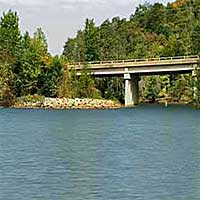 Belews Lake is a 3,860-acre lake with nearly 90 miles of shoreline, heated year round by the power plant. As a result, the growing season is extended for all species. Bass and crappie are the primary targets here, but the lake also has healthy populations of white bass, catfish and sunfish.
Belews Lake is a 3,860-acre lake with nearly 90 miles of shoreline, heated year round by the power plant. As a result, the growing season is extended for all species. Bass and crappie are the primary targets here, but the lake also has healthy populations of white bass, catfish and sunfish.
Primary fish species to catch
Click images for fishing tips and details about each species.
Today's Weather & Forecast
Fishing Boat Rentals
Click here for fishing boat rentals.
Click here for marinas.
Public Boat Launch Ramps & Landings
Click here for boat ramps.
Fishing License
Click here for a North Carolina Fishing License.
Map - Fishing & Access
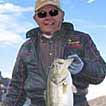 Rick Seaman is a fishing enthusiast with over five decades of fishing experience, a retired tournament fisherman, author of numerous published articles on fishing, and co-author of the book "Bass Fishing - It's not WHAT you throw, It's WHERE you throw it".
Rick Seaman is a fishing enthusiast with over five decades of fishing experience, a retired tournament fisherman, author of numerous published articles on fishing, and co-author of the book "Bass Fishing - It's not WHAT you throw, It's WHERE you throw it".
 Contact Information
Contact Information
Carolina Marina
548 Shelton Rd
Stokesdale, NC 27357
336 427-0498
Fishing lakes in each state
102325
Belews Lake, North Carolina Report
NORTH CAROLINA


Bass, crappie and catfish fishing in northwest NC.


